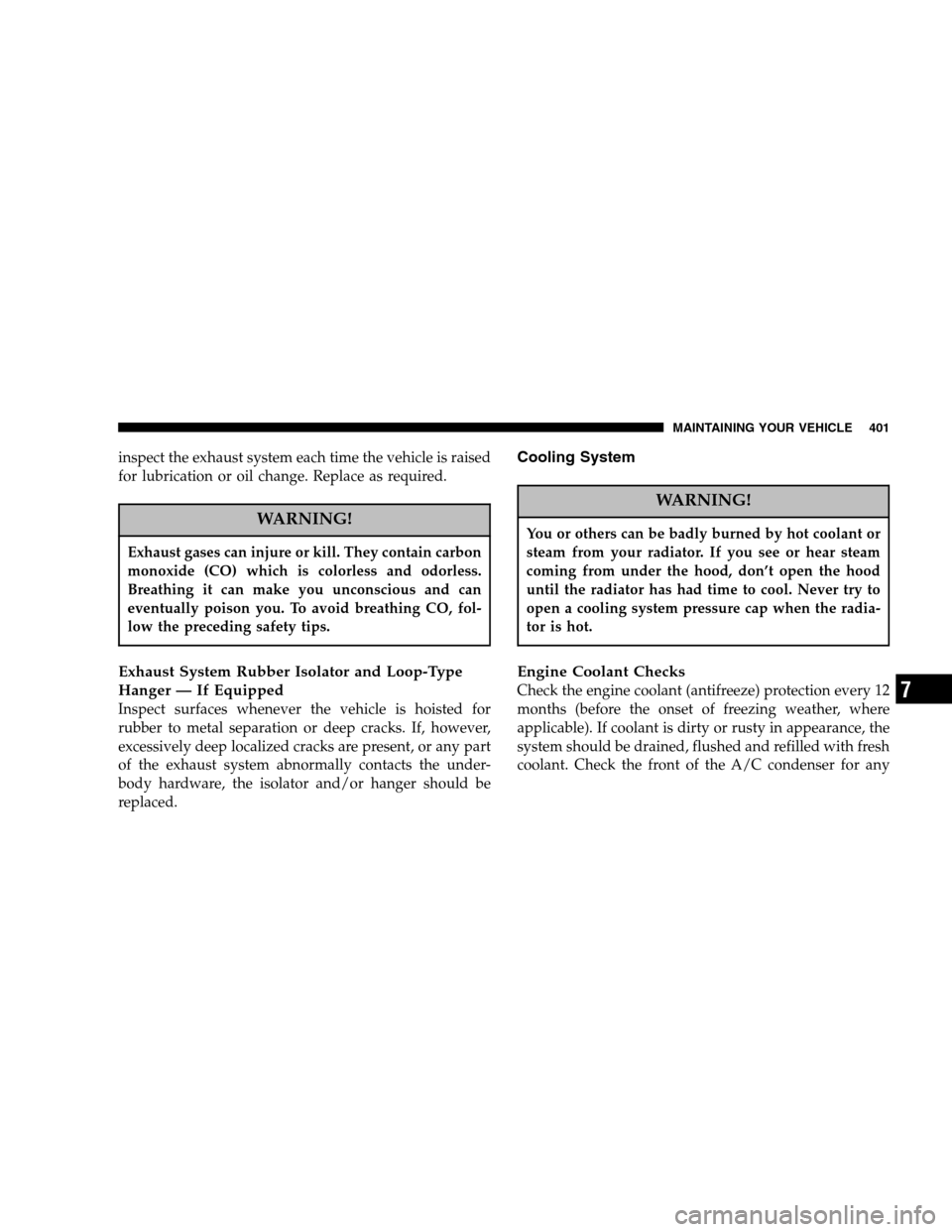Page 389 of 496

Disposing Of Used Engine Oil And Filter
Care should be taken in disposing of the used engine
fluids from your vehicle. Used fluids, indiscriminately
discarded, can present a problem to the environment.
Contact your local dealer, service station, or governmen-
tal agency for advice on recycling programs and where
used fluids and filters can be safely discarded in your
area.
Drive Belt
Inspection
Check the belt for intersecting cracks.
•Transverse (across the belt width) cracks are accept-
able.
•Longitudinal (direction of belt length) cracks that
intersect with transverse cracks are NOT acceptable.
Replace the belt if it has unacceptable cracks, is frayed or
has pieces of material missing. The engine speed sensor, located near the damper, should
be inspected for damage if a belt is frayed.
Engine Air Cleaner Filter
CAUTION!
All air entering the engine intake must be filtered.
The abrasive particles in unfiltered air will cause
rapid wear to engine components.
The air filter housing on your Diesel Ram is equipped
with a Filter Minder™. This is an air flow restriction
gauge that will indicate when the filter element needs to
be replaced.
MAINTAINING YOUR VEHICLE 389
7
Page 391 of 496
A visual inspection of the air cleaner filter element is
never recommended under normal circumstances. A
badly restricted element may appear clean while a soiled
element may be quite effective in filtering particles
without restricting air flow. Rely on the Filter Minder™
to determine when a filter change is necessary.
After a new filter element is inserted, press the rubber
button on the top of the Filter Minder™. This action will
reset the yellow disc to the clean position.
CAUTION!
When using an engine cleaner or a degreaser, be sure
to wrap and tape the Filter Minder™ to protect the
plastic housing from damage and discoloration.
CAUTION!
Many aftermarket performance air filter elements do
not adequately filter the air entering the engine. Use
of such filters can severely damage your engine.
Draining Fuel/Water Separator Filter
MAINTAINING YOUR VEHICLE 391
7
Page 399 of 496

Body Lubrication
Locks and all body pivot points, including such items as
seat tracks, doors, liftgate and hood hinges, should be
lubricated periodically to assure quiet, easy operation
and to protect against rust and wear. Prior to the appli-
cation of any lubricant, the parts concerned should be
wiped clean to remove dust and grit; after lubricating
excess oil and grease should be removed. Particular
attention should also be given to hood latching compo-
nents to insure proper function. When performing other
underhood services, the hood latch, release mechanism
and safety catch should be cleaned and lubricated.
The external lock cylinders should be lubricated twice a
year, preferably in the fall and spring. Apply a small
amount of a high quality lubricant such as Mopar �Lock
Cylinder Lubricant directly into the lock cylinder.
Windshield Wiper Blades
The rubber edges of the wiper blades and the windshield
should be cleaned periodically with a sponge or soft cloth
and a mild nonabrasive cleaner. This will remove accu-
mulations of salt or road film.
Operation of the wipers on dry glass for long periods
may cause deterioration of the wiper blades. Always use
washer fluid when using the wipers to remove salt or dirt
from a dry windshield.
Avoid using the wiper blades to remove frost or ice from
the windshield. Keep the blade rubber out of contact with
petroleum products such as engine oil, gasoline, etc.
Windshield Washers
The fluid reservoir is located under the hood and should
be checked for fluid level at regular intervals. Fill the
reservoir with windshield washer solvent only (not ra-
diator antifreeze).
MAINTAINING YOUR VEHICLE 399
7
Page 401 of 496

inspect the exhaust system each time the vehicle is raised
for lubrication or oil change. Replace as required.
WARNING!
Exhaust gases can injure or kill. They contain carbon
monoxide (CO) which is colorless and odorless.
Breathing it can make you unconscious and can
eventually poison you. To avoid breathing CO, fol-
low the preceding safety tips.
Exhaust System Rubber Isolator and Loop-Type
Hanger — If Equipped
Inspect surfaces whenever the vehicle is hoisted for
rubber to metal separation or deep cracks. If, however,
excessively deep localized cracks are present, or any part
of the exhaust system abnormally contacts the under-
body hardware, the isolator and/or hanger should be
replaced.
Cooling System
WARNING!
You or others can be badly burned by hot coolant or
steam from your radiator. If you see or hear steam
coming from under the hood, don’t open the hood
until the radiator has had time to cool. Never try to
open a cooling system pressure cap when the radia-
tor is hot.
Engine Coolant Checks
Check the engine coolant (antifreeze) protection every 12
months (before the onset of freezing weather, where
applicable). If coolant is dirty or rusty in appearance, the
system should be drained, flushed and refilled with fresh
coolant. Check the front of the A/C condenser for any
MAINTAINING YOUR VEHICLE 401
7
Page 402 of 496

accumulation of bugs, leaves, etc. If dirty, clean by gently
spraying water from a garden hose vertically down the
face of the condenser.
Check the coolant recovery bottle tubing for brittle rub-
ber, cracking, tears, cuts and tightness of the connection
at the bottle and radiator. Inspect the entire system for
leaks.
Extremely cold ambient temperature may require the
addition of a “winter front” for effective operation of the
cab heating/cooling system. Make certain that a percent-
age of the radiator is exposed for adequate air flow
through the charge air cooler and automatic transmission
oil cooler. The percentage of opening must be increased
with the increasing ambient air temperature and/or
engine load. If the cooling fan can be heard cycling
frequently, increase the size of the opening in the winter
front.Coolant bottle level check
The coolant reserve system provides a quick visual
method of determining that the coolant level is adequate.
With the engine idling, and warmed to the normal
operating temperature, the level of the coolant on the
coolant bottle should be between the fluid level marks.
Check the coolant level whenever the hood is raised.
The radiator normally remains completely full, so there is
no longer a need to remove the coolant pressure cap
except for checking coolant freeze point or replacement
with new antifreeze coolant.
402 MAINTAINING YOUR VEHICLE
Page 410 of 496
With disc brakes the fluid level can be expected to fall as
the brake linings wear. However, an unexpected drop in
fluid level may be caused by a leak and a system check
should be conducted.
Refer to Fluids, Lubricants and Genuine Parts for the
correct Fluid type.
WARNING!
Use of a brake fluid that may have a lower initial
boiling point, or unidentified as to specification,
may result in sudden brake failure during hard
prolonged braking. You could have an accident.
WARNING!
Overfilling the brake fluid reservoir can result in
spilling brake fluid on hot engine parts and the
brake fluid catching fire.
Use only brake fluid that has been in a tightly closed
container to avoid contamination from foreign matter or
moisture.
CAUTION!
Do not allow a petroleum-base fluid to contaminate
the brake fluid. Seal damage and loss of brake
performance may result.
410 MAINTAINING YOUR VEHICLE
Page 445 of 496
3. Pull the bulb straight out from the socket.
4. Reverse procedure for installation of bulbs and hous-
ing.
Side Marker Lights (Dual Rear Wheels)
1. Push rearward on the side marker light assembly.
2. Pull the entire assembly from the fender. 3. Turn socket
1�4turn counterclockwise and remove from
assembly to access the bulb.
4. Pull bulb straight out from socket.
5.
Reverse procedure for installation of bulbs and housing.
FLUID CAPACITIES
FLUID CAPACITIES U.S. Metric
Fuel
2500 Shortbed Models 34 gal. 128L2500 Longbed Models 35 gal. 132L
3500 Shortbed Models 34 gal. 128L 3500 Longbed Models 35 gal. 132L
Engine Oil 5.9L Diesel Engine I-6 12.0 qts. 11.4L
Cooling System 5.9L Diesel Engine I-6 7 gal. 26.5L
MAINTAINING YOUR VEHICLE 445
7
Page 446 of 496
FLUIDS, LUBRICANTS AND GENUINE PARTS
Engine
Component Fluids, Lubricants and Genuine Parts
Engine Coolant Mopar �Antifreeze/Coolant 5 Year/100,000 Mile Formula HOAT (Hybrid Or-
ganic Additive Technology) or equivalent.
Engine Oil For the proper quality and SAE Grade oil for your engine, refer to the section � Maintenance Procedures.�
Engine Oil Filter Mopar �Engine Oil Filter, P/N 05083285AA or equivalent.
Engine Fuel Filter Mopar �Fuel Filter, P/N 05015581AB or equivalent.
Fuel Selection Use good quality diesel fuel from a reputable supplier. For most year-round service, No. 2 diesel fuel meeting ASTM specification D-975 will provide
good performance. This vehicle is fully compatible with biodiesel blends
up to 5% biodiesel meeting ASTM specification D-975. (See page 318 for
more information.)
446 MAINTAINING YOUR VEHICLE